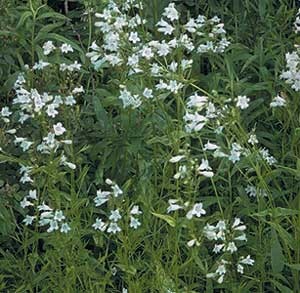Article Written by noreply@blogger.com (Heather Holm) on Dec 07, 2012 03:16 pm

Tall Beard Tongue ~ Penstemon digitalis
Beard tongue flowers have a large, hairy staminode on the lower half of the tubular flower which restricts access to bees to the flower and helps in pollen deposition. Small to medium sized bees are the most frequent visitors.
Tall Beard Tongue flowers can be white to light pink, sometimes with darker pink to purple stripes which act as nectar guides for bees.
Small Carpenter Bees (Ceratina spp) visit Tall Beard Tongue flowers primarily to feed on pollen. Their small size allows them to easily climb over the staminode into the tubular flowers to access the pollen on the anthers.
As they feed on pollen, they often inadvertently contact the stigma. The hairs on the staminode keep their bodies held closer to the stigma, resulting in more contact and pollen transfer.
Digger Bees (Anthophora spp.) are frequent visitors to Tall Beard Tongue flowers as well. They are fast moving and visit flowers for a very short time frame compared to Small Carpenter Bees.
Their medium sized bodies and long tongues allow them access into the tubular flower which results in abundant pollen removal as their bodies scrape on the anthers above.
Bumble Bees (Bombus spp.) are not primary pollinators of Tall Beard Tongue. Visiting the flowers for nectar, they are able to reach the nectar reward with their long tongues without having to insert their body into the corolla and come away with pollen on their bodies.
Look for small holes chewed at the base of the flower. Mason Wasps will chew holes to reach the nectar reward without having to enter the flower. Smaller bees will take advantage of these nectar thievery holes.
The Interaction between Pollinator Size and the Bristle Staminode of Penstemon digitalis (Scrophulariaceae) Gregg Dieringer and Leticia Cabrera R. American Journal of Botany , Vol. 89, No. 6 (Jun., 2002), pp. 991-997
© Heather Holm, 2012.
Article From Restoringthelandscape Website
To Purchase Tall Beard Tongue ~ Penstemon digitalis Visit Us At Ion Exchange, Inc.
Ion Exchange, Inc. Native Wildflowers & Prairie Plants Website
Call 1-800-291-2143

